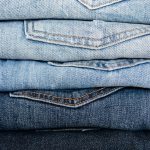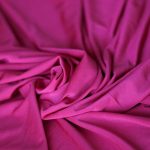You’ll notice woven fabrics have a tight, grid-like structure from interlaced yarns, making them durable, breathable, and better for repeated use. Nonwoven fabrics use bonded fibers, which means they’re lighter and cheaper but less durable and less breathable. Woven fabrics often use natural fibers with easier recycling, while nonwovens mostly rely on synthetics. If you want a deeper understanding of their strengths, weaknesses, and applications, there’s plenty more to explore.
Table of Contents
Key Takeaways
- Woven fabrics have interlaced yarns creating a strong, durable structure, while nonwovens bond fibers randomly, resulting in lower durability.
- Woven fabrics exhibit a distinct grid pattern and consistent texture; nonwovens display a random, web-like fiber arrangement without specific alignment.
- Woven fabrics allow better breathability and airflow, enhancing comfort, whereas nonwovens often trap heat and moisture due to fiber bonding.
- Woven fabrics typically use natural, biodegradable fibers but demand more water and pesticides; nonwovens mostly use synthetic fibers from petrochemicals.
- Woven fabrics are easier to recycle or compost, while nonwovens are often designed for single-use, disposable applications like medical masks and wipes.
Definition and Manufacturing Processes of Woven and Nonwoven Fabrics
Understanding the basics of woven and nonwoven fabrics helps you appreciate their unique characteristics.
Woven fabrics form when yarns interlace at right angles, creating a grid-like pattern. You’ll find this method in materials like denim and cotton shirts. The process involves weaving on looms, which tightly intertwine warp and weft yarns.
On the other hand, nonwoven fabrics don’t use yarns at all. Instead, fibers bond together through heat, chemicals, or mechanical action. You can think of it like pressing fibers into a mat. This technique makes nonwovens perfect for disposable items like wipes or medical masks.
Structural Differences Between Woven and Nonwoven Fabrics
Although woven and nonwoven fabrics may look similar at first glance, their structures differ considerably.
When you examine woven fabrics, you’ll see a distinct pattern created by interlacing yarns at right angles—warp and weft threads cross over and under each other, forming a grid-like structure. This organized arrangement provides a consistent texture and appearance.
On the other hand, nonwoven fabrics lack this orderly pattern. Instead, they’re made by bonding or entangling fibers randomly, using mechanical, chemical, or thermal methods. You won’t find the neat rows and columns here; the fibers form a web-like mat without any specific alignment.
Nonwoven fabrics feature randomly bonded fibers forming a web-like mat without neat rows or specific alignment.
This fundamental difference impacts how each fabric behaves and feels, influencing your choice depending on the application.
Durability and Strength Comparison
The unique structures of woven and nonwoven fabrics directly affect their durability and strength. Woven fabrics have interlaced yarns, creating a tight, sturdy network that resists tearing and withstands repeated use.
If you need fabric that holds up under stress, woven is often your best bet. Nonwoven fabrics, however, are bonded fibers rather than woven threads, making them less durable for heavy-duty applications. They’re great for disposable or lightweight uses but won’t last as long when subjected to frequent wear or tension.
When choosing between the two, consider how much strength you require. If durability is critical, woven fabrics typically outperform nonwovens, offering better resistance to abrasion and stretching, so you can count on them for long-term use.
Breathability and Comfort Factors
When you choose fabric for clothing or upholstery, breathability and comfort play a key role in how it feels against your skin.
Woven fabrics, with their interlaced yarns, naturally allow air to flow, helping you stay cool and dry. This makes them ideal for garments you wear daily or furniture you sit on for hours.
Woven fabrics’ interlaced yarns promote airflow, keeping you cool and comfortable throughout the day.
Nonwoven fabrics, on the other hand, are made by bonding fibers together, often resulting in less airflow. While they can be soft and lightweight, they may trap heat and moisture, which might reduce comfort in warm conditions.
So, if breathable comfort tops your list, woven fabrics usually have the edge.
Still, consider the specific use and fabric treatment, as these also influence how comfortable and breathable a fabric truly feels to you.
Environmental Impact and Sustainability Considerations
Since you’re likely concerned about how your fabric choices affect the planet, it’s important to weigh the environmental impact and sustainability of woven and nonwoven fabrics.
Woven fabrics typically use natural fibers like cotton or wool, which are biodegradable but can require significant water and pesticide use during cultivation. Nonwoven fabrics often rely on synthetic fibers derived from petrochemicals, making them less eco-friendly and slower to decompose.
However, advances in recycled materials and biodegradable nonwovens are improving sustainability. When choosing, consider the production energy, waste generated, and end-of-life options.
Woven fabrics generally allow easier recycling or composting, while nonwovens might contribute more to landfill waste unless specifically designed for recyclability. Your choice can support eco-conscious practices by prioritizing materials with lower environmental footprints.
Common Applications and Industry Uses
Choosing between woven and nonwoven fabrics doesn’t just affect the environment—it also shapes the way these materials perform across various industries.
When you need durability and strength, woven fabrics are your go-to, widely used in apparel, upholstery, and outdoor gear. Their tight weave offers reliable performance for long-term use.
On the other hand, nonwoven fabrics excel in disposable and single-use applications, like medical masks, filters, and hygiene products, thanks to their breathability and cost-effectiveness.
You’ll find nonwovens dominating sectors where quick production and specific functions, like liquid repellency or filtration, matter most.
Knowing each fabric’s strengths helps you pick the right material for your project, whether you prioritize resilience, comfort, or specialized performance in industries ranging from fashion to healthcare and automotive.
Cost Efficiency and Production Speed Analysis
Although both woven and nonwoven fabrics serve distinct purposes, their cost efficiency and production speed often determine which you’ll select for a specific application.
Nonwoven fabrics typically offer faster production speeds since they skip the weaving process, allowing you to produce large quantities quickly and at a lower cost. This makes them ideal for disposable products or when you need rapid turnaround.
Nonwoven fabrics enable rapid, cost-effective production ideal for disposable items and quick project completion.
Woven fabrics, on the other hand, require more time and labor, increasing costs but providing greater durability and strength. If your project demands longevity and repeated use, investing in woven fabric might be worth it despite slower production.
Ultimately, you’ll weigh whether speed and affordability or durability and quality matter more for your needs, guiding your choice between these two fabric types.
Frequently Asked Questions
How Do Woven and Nonwoven Fabrics Differ in Dye Absorption?
You might think both fabrics absorb dye similarly, but they don’t. You’ll find woven fabrics absorb dye evenly due to tight threads, while nonwovens soak it irregularly because of their loose, random fiber arrangement.
Can Woven and Nonwoven Fabrics Be Recycled Together?
You can’t recycle woven and nonwoven fabrics together easily because they have different structures and fibers. Mixing them complicates processing, so you’ll need to separate them for effective recycling and better material recovery.
Are There Specific Care Instructions Unique to Each Fabric Type?
You’ll find woven fabrics often need gentle washing to maintain their structure, while 60% of nonwoven fabrics resist water better but can’t handle high heat. So, you’ll want to follow care labels carefully for each type.
How Do Woven and Nonwoven Fabrics Perform in Extreme Temperatures?
You’ll find woven fabrics handle extreme temperatures better, offering durability and breathability. Nonwoven fabrics, however, may degrade or lose strength under heat or cold, so you should use them cautiously in harsh conditions.
What Are the Historical Origins of Woven Versus Nonwoven Fabrics?
Picture ancient hands weaving threads into intricate patterns—wovens date back thousands of years, rooted in early civilizations. Nonwovens, though, emerged recently, crafted by bonding fibers without weaving, revolutionizing fabric production in the 20th century.
- The Ultimate Comparison: Woven vs. Nonwoven Fabric Properties - July 11, 2025
- Nonwoven Polypropylene Safety: A Full Breakdown - July 11, 2025
- Care Instructions for Nonwoven Fabrics: Washing and Drying - July 11, 2025







